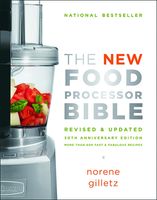Label
All
0
Clear all filters
Prue Leith's latest book is now on ckbk. Get 25% off ckbk Membership
Vegetables and Side Dishes
Appears in
Published 2011
- Side dishes that do not contain any dairy products (e.g., Lokshin Kugel) can be served with either meat or dairy meals, so they are in this chapter. For side dishes containing dairy products, see the Fish and Dairy chapter.
- Refer to the Smart Chart for basic vegetable processing techniques.
- Choose vegetables that are firm and not too ripe. Remove the core, large pits and seeds before processing.
- The wide-mouth feed tube is excellent for slicing or grating whole round fruits and vegetables (e.g., lemons, tomatoes, onions).
- The small feed tube (mini-tube) is ideal for single or small items. If vegetables are wide at 1 end and narrow at the other (e.g., carrots), pack them in pairs, alternating 1 wide end up and 1 narrow end up.
- Before slicing or grating/shredding vegetables, cut the bottom ends flat; place them in the feed tube flat side down. Pack the feed tube snugly, but not so tightly that the pusher can’t move.
- Cut vegetables in lengths to fit the feed tube. Some newer models of food processors have a marking on the feed tube to indicate the maximum height for filling. Don’t overfill the feed tube or the machine won’t start when you press down on the pusher!
- If the vegetables don’t fit, try inserting them from the bottom of the feed tube where the opening is slightly larger.
- The mini-feed tube (if your machine has one) is ideal for slicing or shredding long vegetables or small items (e.g., 1 or 2 carrots, zucchini, green onions, celery).
- For short shreds, pack the vegetables (e.g., carrots, zucchini) in the feed tube upright. For long, narrow shreds, pack the feed tube horizontally.
- The pusher assembly for the wide-mouth feed tube has a small pusher that fits inside the small feed tube. The small pusher must be in place when using the wide-mouth feed tube; otherwise, food will bounce up and down in the small feed tube instead of being sliced or grated. (I speak from experience!)
- In general, use medium pressure for most vegetables (e.g., potatoes, celery, zucchini). Use firm pressure for hard vegetables (e.g., carrots, sweet potatoes). Use light pressure for tomatoes or cabbage.
- CHEATER CHOP: For an easy way to “chop” vegetables, cut them in 1-inch chunks, place them in the feed tube and process on the Slicer, using light pressure.
- For more control when slicing or grating vegetables, use the PULSE button. Press down on the pusher with 1 hand and press PULSE with the other; release pulse as soon as the food is sliced or shredded. The processor will stop instantly!
- For continuous feed, use either the ON or PULSE button. If you use the ON button, 1 hand will be free to refill the feed tube.
- Cooking time for vegetables varies depending on the type of vegetable and whether they are whole, sliced or chopped. Estimate 3 to 4 minutes for grated vegetables, 5 to 6 minutes for sliced vegetables, and 10 to 15 minutes for whole vegetables. Taste and check.
- To microwave vegetables, soak them in cold water and shake them dry. The water clinging to the vegetables provides enough steam to cook them. Allow 5 to 7 minutes per lb on High. Stir or turn vegetables over halfway through cooking. If they have a skin (e.g., potatoes, squash), pierce before microwaving.
- GRATINÉED VEGETABLES: Top cooked vegetables with Béchamel Sauce or Cheese Sauce; sprinkle with buttered seasoned crumbs. Bake 15 to 20 minutes at preheated 350°F, until bubbling and nicely browned.
- Store potatoes and onions separately in a cool, dark place to prevent spoiling. If refrigerated, potatoes will develop a sweet taste.
- RESCUED MASHED POTATOES: Here’s a tried and true remedy to rescue overprocessed mashed potatoes, based on 3 to 4 potatoes. Add ¼ cup milk, 2 Tbsp margarine, 1 egg, ½ tsp baking powder, salt and freshly ground black pepper to mashed potatoes. Process on the Steel Blade 30 seconds, until smooth and sticky. Spread in a sprayed 9-inch pie plate, sprinkle with paprika and Bake at 375°F about 30 minutes, until brown and crusty.
- NOODLE KNOW-HOW: To cook pasta, the general rule is 4 quarts of boiling water and 4 tsp salt for each lb of pasta. Do not cook pasta without salt or it will never taste right.
- Drain pasta as soon as it is cooked. Reheat quickly by placing in boiling water for a minute (or microwave on High, allowing 1 minute per cup). Undercook pasta slightly if you plan to reheat it later.
- Spaghetti and macaroni double when cooked. Other noodles swell slightly. One pound of spaghetti yields 5 to 6 servings. One cup uncooked noodles (2½ oz weight) yields 1¼ cups cooked (2 servings). You can freeze cooked pasta for 4 to 6 months.
- NESTED WORK BOWLS: Choose the appropriate bowl and blade or disc for the task. Use the small bowl to mince garlic or herbs, or for other small tasks. Use the medium or large bowl and appropriate disc to slice or shred/grate veggies, cheese, etc. Use the large bowl and Steel Blade to chop/mince vegetables and to combine ingredients. (You can also use the Steel Blade in the medium bowl on Cuisinart Elite models.)
- OTHER OPTIONS: The Cuisinart Elite food processor comes with an adjustable 6-in-1 slicing disc, which can produce thin, medium or thick slices (1 to 6 mm) with a quick twist of a dial. It also comes with a reversible shredding disc which can produce fine or medium shreds. Also refer to Optional Blades and Discs.
In this section
Advertisement
Advertisement
The licensor does not allow printing of this title


